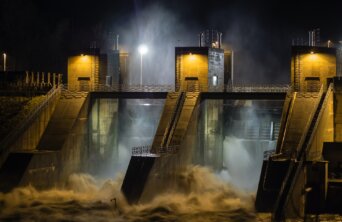- About
- Topics
- Picks
- Audio
- Story
- In-Depth
- Opinion
- News
- Donate
- Signup for our newsletterOur Editors' Best Picks.Send
Read, Debate: Engage.
| topic: | Renewables |
|---|---|
| located: | India |
| editor: | Hanan Zaffar |
India is expected to produce around 1750 Billion units (BU) of electricity in the existing fiscal year - a nearly 7 per cent increase from the last year. The government is under huge pressure to cater to the energy needs of a country of more than 1.3 billion.
While more than 70 per cent of India’s energy requirements come from fossil fuels, the government is trying to speed up its reliance on renewable sources.
Currently, most of India’s renewable energy is produced through hydroelectric projects that involve large dams built across the country. More than 11 per cent of the country’s electricity is now generated through water sources, making India the seventh-largest producer of hydroelectricity in the world.
At present, India has about 197 hydro-power plants, which include both small and large plants. Now, in order to shift further away from fossil fuels and meet the country's increasing energy demand, the government is planning to build additional hydropower plants that would produce large amounts of electricity with almost no pollution.
But despite their reputation as efficient, convenient and environmentally friendly, hydroelectric projects come with their share of problems.
For one, the dams constructed as part of hydro projects require large swaths of land, and typically lead to the displacement of local residents and wildlife.
The construction of these dams therefore tend to have social, cultural and environmental ramifications. Tribal communities in India are deeply connected to rivers and forests, and the removal from their ancestral lands to make way for hydro projects seriously disrupts their way of life and traditions. This often leads to clashes between locals and the authorities.
For instance, the deadline for a hydropower project in the Chamoli region of the Indian state of Uttarakhand has been stalled indefinitely due to stiff opposition from locals. Such projects have also been blamed for the recent massive landslides in the region and therefore face opposition from a growing number of environmentalists. When carried out on a large scale, hydro projects are said to interrupt the ecological balance of the area.
Similarly, in the Dibang Valley of Arunachal Pradesh, the indigenous community of Idu Mishmis has been opposing the proposed Etalin Hydroelectric Project. The project is said to be built on the Dibang River, a tributary of the Brahmaputra, which is considered holy to Idu Mishmis. As per their belief, departed souls make their journey through this river to heaven.
There are several additional examples where such projects face opposition from indigenous people for reasons varying from tradition, livelihood and culture. This further complicates the attempt to meet the country's energy needs in a clean and sustainable manner.
Despite the apparent resistance on the ground, India is set to commission seven new hydroelectric power projects in the current fiscal year, with a total capacity of 3110 megawatts. Focusing primarily on the northeastern part of the country, the Indian government seems determined to tap into hydroelectricity's potential as a clean energy source.
Image by Jani Brumat.

